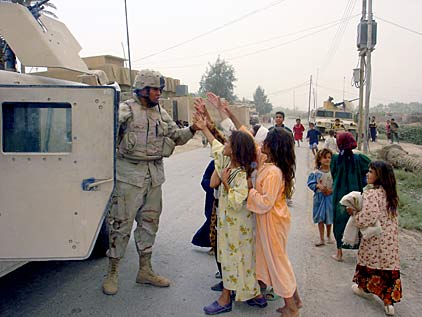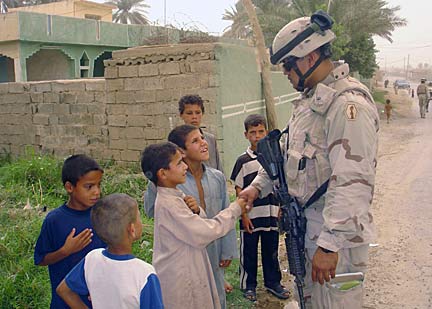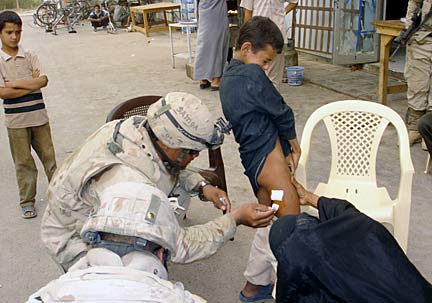
Spc. Savaki Sua hands out candy to children in Albu Hishma, Iraq. The children mob American soldiers in every village; they know the soldiers carry candy and other items for them.
Isle soldier sees behind
the lines of Iraqi life
Sun, dust and shakas
are part of a patrol day
BALAD, Iraq » The patrol briefing was to the point: We would be conducting a routine route clearance to deter the emplacement of improvised explosive devices along major supply routes around Logistical Support Area Anaconda, as well as conducting counter-cache operations to deny the enemy access to weapons and ammunition. The soldiers from the 2nd Platoon, Company B, 100th Battalion, 442nd Infantry have been performing these types of missions daily for about five months now. Company B is comprised mostly of infantrymen from American Samoa and has been supplemented by both volunteers and cross-leveled soldiers from all across the United States. Our patrol was led by Staff Sgt. Uluao Leituli from American Samoa.
The 29th Brigade Combat Team, which includes the 100th Battalion 442nd Infantry, arrived in theater in late January of this year. Shortly after arrival, the change in season from winter to spring happened almost overnight. The Iraqi winter was wet, cold and muddy. The skies were overcast and rain visited in occasional deluges. Poor drainage and the oversaturated soil led to ponds of placid brown water that dominated nearly every open area on the base. The ponds became mock reflecting pools mirroring images of the mundane: porta-potties, trailers and metal shipping connexes.
Thick gooey mud was everywhere, adhering itself to everything it contacted. Vehicle tires became giant mud doughnuts covered with gravel sprinkles, while Army boots became awkward cement clodhoppers after a stroll through the stuff. Then one day the rain stopped, the sky cleared and the puddle-ridden fields became dry, dusty bowls in a matter of days, signaling the onset of spring.

Staff Sgt. Uluao Letuli of 2nd Platoon, Company B, 100th Battalion, 442nd Infantry shakes the hands of children during a foot patrol through the village of Albu Hishma. Iraqi children often run to greet soldiers and ask for candy. Sometimes the children offer shakas, which they've learned from the Hawaii-based troops.
We left the wire at noon, at the start of the hottest time of the day. An anemic air-conditioning unit in our Humvee pumped arid, semi-cool air over us as we baked in the box-like interior of the steel vehicle.
Our patrol passed along the raised dirt roads that meander through the fields of the rural agricultural communities that surround LSA Anaconda. Irrigation canals filled with tall weeds and fecund green water line many of the roads. Little girls herd flocks of sheep, goats and sometimes a few scrawny cattle, while women of various ages labor under the desert sun using long-handled shovels to turn the bleached soil. Most of the older women are draped from the neck down in black, loose-fitting outer garments called "abayah," the modest nun-like covering that Arab women wear. The younger women wear conservative printed coverings of the same design. The heads of both young and old women are swathed in "hejab," the linen wrapping that allows only their faces to be seen. Their clothing appears as confining and stifling as it is proper and traditional, but they seem impervious to the oppressive heat. The resigned, even pace of their work is contrasted by their vibrant young children who play near them in the fields. The women work as their parents have, as well as their parents before them for generations. Though they work hard and perform important roles, in general women occupy a low rung on the Iraqi social ladder. The women pay no attention as our patrol rumbles past. Conservative Muslim tradition doesn't allow them to look at or speak with males outside of their families.
We passed homes either spread out across the countryside or clustered in small villages; most of the homes are humble dwellings made of cement or mud brick. The mud bricks are mixed with straw for strength, giving them a hairy appearance. The bricks weather over time, melting into each other until they eventually form solid hairy walls of earth.

A concerned grandmother, lower right, flagged down the patrol in Bakr Village near Balad, Iraq, as she was concerned for her grandson, who had been bitten by a dog. Pfc. Jack Tinae provided medical care, cleaning the wound and bandaging it. The 100th-442nd soldiers have become well liked and have earned the respect of the villagers in their area of operations.
Some of the children deal with the heat of the day by splashing about naked in the canals; occasional huddles of women scrub clothing piled in wicker baskets along the shores. Many of the children flash the Hawaiian "shaka" sign that the 100th Battalion 442nd Infantry soldiers have taught them.
The day settled into late afternoon and the sun cast the golden glow of a French impressionist's painting upon the fields and laborers. The shadows lengthened and the outline of our hulking armored Humvees shimmered across the timeless scene as we passed by. For a brief moment, the old and the new, the traditional and the modern were intermingled as our shadows crossed each other. Iraq is a land of many paradoxes.
We dismounted in the village of Albu Hishma and patrolled the village's main street. The children were full of smiles and friendly; they've become accustomed to the generosity of the soldiers and follow them wherever they go. Some of the children were unkempt, with matted, tangled hair. Many were without shoes and shouted, "Mista, you give me!" as they held out empty hands to the soldiers.
According to Sgt. John McElroy, the 2nd platoon has been hit twice by improvised explosive devices in the past few months. The first was set near a fake IED in the middle of the road. According McElroy, when the patrol stopped to avoid the fake, the insurgents set off the large explosive device that had been hidden nearby. The explosion showered the patrol with shrapnel and debris and was followed by incoming mortar rounds that exploded nearby.
"The IED was a big one, so it was really loud when it went off," said McElroy. None of the infantrymen were injured in the attack. According McElroy, many of the 100th Battalion 442nd Infantry patrols have experienced IED attacks since taking over this area of operations near Balad, in the heart of the Sunni Triangle.
The fiery Arabian sunset was accentuated by the absence of electrical lights in the area. As evening approached, the sun's passing was marked by the Bakr village imam (Muslim priest), who summoned the faithful to the Salat-El-Meghrib or "sunset prayer." The imam's voice reverberated across the quiet countryside like a surreal blanket, projected from a loud speaker in the mosque's minaret.
Evening brought out the bats. They flitted about haphazardly, like dark leaves buffeted by an unfelt wind that doesn't allow them to fall; they swirled to the backdrop of a hazy purplish sky and a rising full moon. The peacefulness of the evening belied the danger outside LSA Anaconda's barbed wire. To date, 36 soldiers from the 100th Battalion 442nd Infantry have been wounded in action. A total of 49 soldiers from the 29th BCT have been wounded in combat, and two have been killed in action. The 29th BCT is about halfway through its yearlong combat tour in Iraq.
[News] [Business] [Features] [Sports] [Editorial] [Do It Electric!]
[Classified Ads] [Search] [Subscribe] [Info] [Letter to Editor]
[Feedback]
